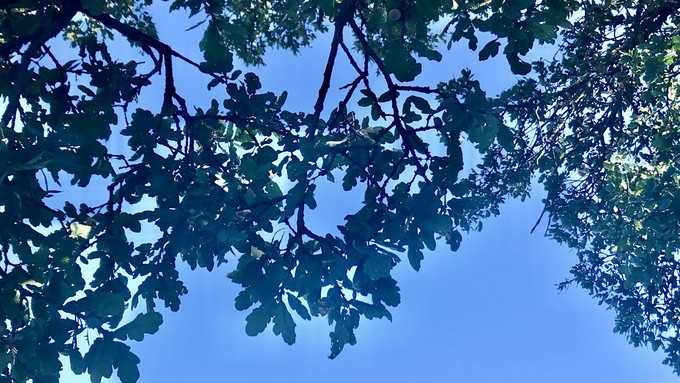
Arborist to conduct free lunchtime session on tree selection

An oak tree overhead is a guarantee of shade. California native oaks are low-water trees, but they have certain care needs, too. Kathy Morrison
There are, I'm told, no bad trees -- only bad locations.
Oh, like the mature olive tree planted right next to the sidewalk corner of two busy streets. Or the pair of still-young western redbuds smack in the middle of a very green lawn. I pass these on my walks around the neighborhood.
These are nice trees that would thrive in other locations. As they are, one is a source of annoyance and possible slipping on the sidewalk when the olives ripen, and the others are in danger of developing crown rot if watered too frequently.
The Citrus Heights Water District next week is offering a free webinar that can help homeowners choose the right tree for a low-water yard, and avoid planting trees that become problems.
At noon, Wednesday, Aug. 28, the district presents "Leaf with the Right Tree: A Guide to Regional Tree Selection."
Here's how they describe the one-hour session: "Want a beautiful, cooling tree in your yard but also want to save water and keep maintenance low? Or maybe you have trees but aren’t sure how to care for them?
"Join Sacramento Tree Foundation’s arborist Pamela Sanchez to learn about the best trees go hand in hand when you combine the right species with smart irrigation techniques and low-water landscapes, creating the perfect shady environment."
Sanchez is an ISA certified arborist with a degree in urban forestry from UC Davis and more than 10 years of experience.
Those who register and attend will have a chance to win a $100 gift card from Green Acres Nursery & Supply, the district notes.
To register for the webinar, go here.
For more information on trees and tree planting, visit the Sacramento Tree Foundation website, sactree.org.
Comments
0 comments have been posted.Sacramento Digs Gardening to your inbox.
Food in My Back Yard Series
May 6: Maintain soil moisture with mulch for garden success
April 29: What's (already) wrong with my tomato plants?
April 22: Should you stock up on fertilizer? (Yes!)
April 15: Grow culinary herbs in containers
April 8: When to plant summer vegetables
April 1: Don't be fooled by these garden myths
March 25: Fertilizer tips: How to 'feed' your vegetables for healthy growth
March 18: Time to give vegetable seedlings some more space
March 11: Ways to win the fight against weeds
March 4: Potatoes from the garden
Feb. 25: Plant a fruit tree now -- for later
Feb. 18: How to squeeze more food into less space
Feb. 11: When to plant? Consider staggering your transplants
Feb. 4: Starting in seed starting
Sites We Like
Garden Checklist for week of May 4
Enjoy this spring weather – and get gardening!
* Plant, plant, plant! It’s prime planting season in the Sacramento area. Time to set out those tomato transplants along with peppers and eggplants. Pinch off any flowers on new transplants to make them concentrate on establishing roots instead of setting premature fruit.
* Direct-seed melons, cucumbers, summer squash, corn, radishes, pumpkins and annual herbs such as basil.
* Harvest cabbage, lettuce, peas and green onions.
* In the flower garden, direct-seed sunflowers, cosmos, salvia, zinnias, marigolds, celosia and asters. (You also can transplant seedlings for many of the same flowers.)
* Plant dahlia tubers. Other perennials to set out include verbena, coreopsis, coneflower and astilbe.
* Transplant petunias, marigolds and perennial flowers such as astilbe, columbine, coneflowers, coreopsis, dahlias, rudbeckia and verbena.
* Keep an eye out for slugs, snails, earwigs and aphids that want to dine on tender new growth.
* Feed summer bloomers with a balanced fertilizer.
* For continued bloom, cut off spent flowers on roses as well as other flowering plants.
* Add mulch to the garden to maintain moisture. Mulch also cuts down on weeds. But don’t let it mound around the stems or trunks of trees or shrubs. Leave about a 6-inch to 1-foot circle to avoid crown rot or other problems.